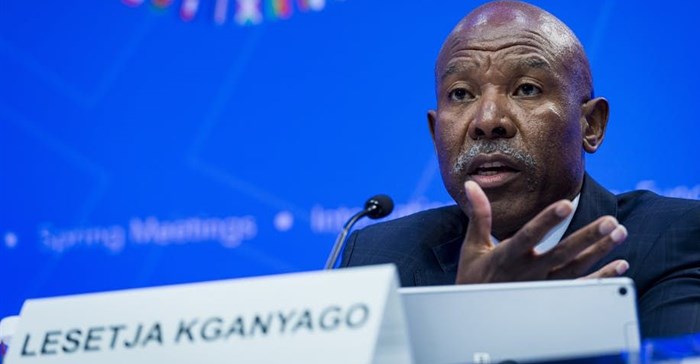
Lesetja Kganyago, governor of South Africa’s central bank. EPA-EFE/Pete Marovich
The three debates are somewhat convoluted. They are indeed three different issues, but they are interlinked.
Let’s turn to the issue of ownership first.
The South African Reserve Bank is one of only eight central banks in the world with private shareholders. The others are in Belgium, Greece, Italy, Japan, San Marino, Switzerland and Turkey.
The debate about shareholding in South Africa’s Reserve Bank centres around the issue of nationalisation. Some political players, such as the third largest party – the Economic Freedom Fighters – are calling for the ownership of the bank to be transferred from current private shareholders to the South African government and has tabled a bill in parliament to achieve this objective.
The issue is very charged. But it’s also confused and not very well understood. There’s an assumption that a change of ownership would automatically mean a change in the role the bank plays. This isn’t the case because in fact the bank’s shareholders play no role in its mandate. In that sense it doesn’t matter who the shareholders are. Because they can’t affect its mandate, nationalisation won’t affect the independence of the central bank.
But there are other ways in which the bank’s ability to do its job can be undermined. This is where the bank’s primary mandate comes in.
The mandate issue
The mandate of South Africa’s central bank is set out in the Constitution, which says:
The primary objective of the bank shall be to protect the value of the currency of the Republic of South Africa in the interest of balanced and sustainable economic growth in the republic.
The bank also adheres to an inflation target which was put in place in 2000. This requires it to keep inflation within a band of 3% to 6%. The bank uses monetary policy and interest rate decisions to achieve this objective. In short, when the inflationary trend declines, the interest rate declines and when the inflationary trend increases, the interest rate increases.The issue of the bank’s focus on keeping inflation within this band – and the fact that its mandate sets out clearly that managing inflation is it’s core job – is hotly contested.
Those on the left of the political spectrum, including the country’s largest trade union federation, argue that the South African Reserve Bank shouldn’t focus primarily on inflation. Instead, they say, it should also be taking account of economic growth as well as the employment rate in the country.
The bank’s response has been that its current mandate is broad enough because it says quite clearly that, while managing inflation, it must do so “in the interest of balanced and sustainable economic growth in the republic”.
For those like myself who oppose a broader mandate, the issue is quite simple: giving the bank a broader mandate raises the danger that the bank will take its eye off inflation because it’s having to concentrate on other issues. This, in turn, could lead to rampant inflation.
The bank’s mandate is crucial in another respect. The SA Reserve Bank’s ability to pursue its mandate without interference from government is how its independence is measured.
South Africa’s central bank has acted on the whim of politicians before. It didn’t end well.
How political interference can hurt
In the 1980s inflation rose dramatically, resulting in the country suffering its highest inflation rates ever: on average about 15% per year for the decade.
Despite the fact that rising prices called for the bank to act by raising interest rates, it failed to do so on instructions of the government. Inflation wreaked havoc on the earnings of ordinary South Africans, as well as on the value of people’s pensions.
The government’s interference was dramatically brought to light ahead of a by-election in 1984 in a Johannesburg suburb called Primrose. Just prior to the by-election the government instructed the South African Reserve Bank to drop the interest rate. This subsequently became known as the Primrose Prime incident.
Where the focus should be
The debates swirling around the central bank have created uncertainty. This is despite reassurances from South African President Cyril Ramaphosa.
The president needs to do more: he also needs to establish certainty about the executive management of the South African Reserve Bank.
An executive vacancy at the central bank, created by the resignation of one of the deputy governors, Francois Groepe, must be filled as a matter of urgency. And the president should make clear his intention to reappoint the governor, Lesetja Kganyago, and the deputy governor, Daniel Mminele, whose terms expire this year.
These appointments are under the purview of the president. The SA Reserve Bank Act stipulates that the president must fill executive positions after consultation with the minister of finance and the bank’s board.
South Africa needs stability at the central bank to ensure a growth trajectory for the country. The president should get the process of filling the vacancy and providing certainty about the future of Kganyago and Mminele underway sooner rather than later.
This article is republished from The Conversation under a Creative Commons license. Read the original article.








































